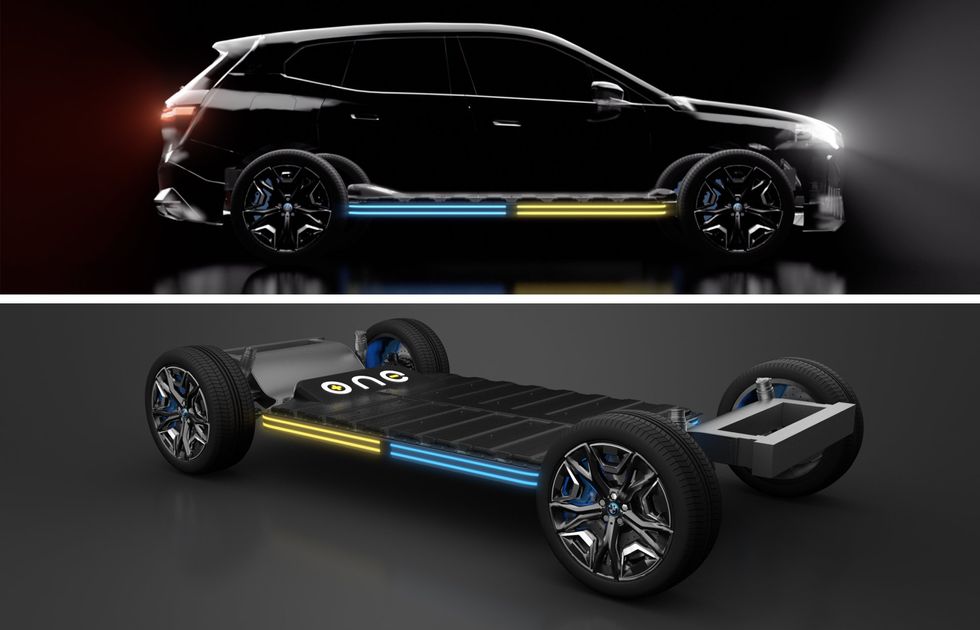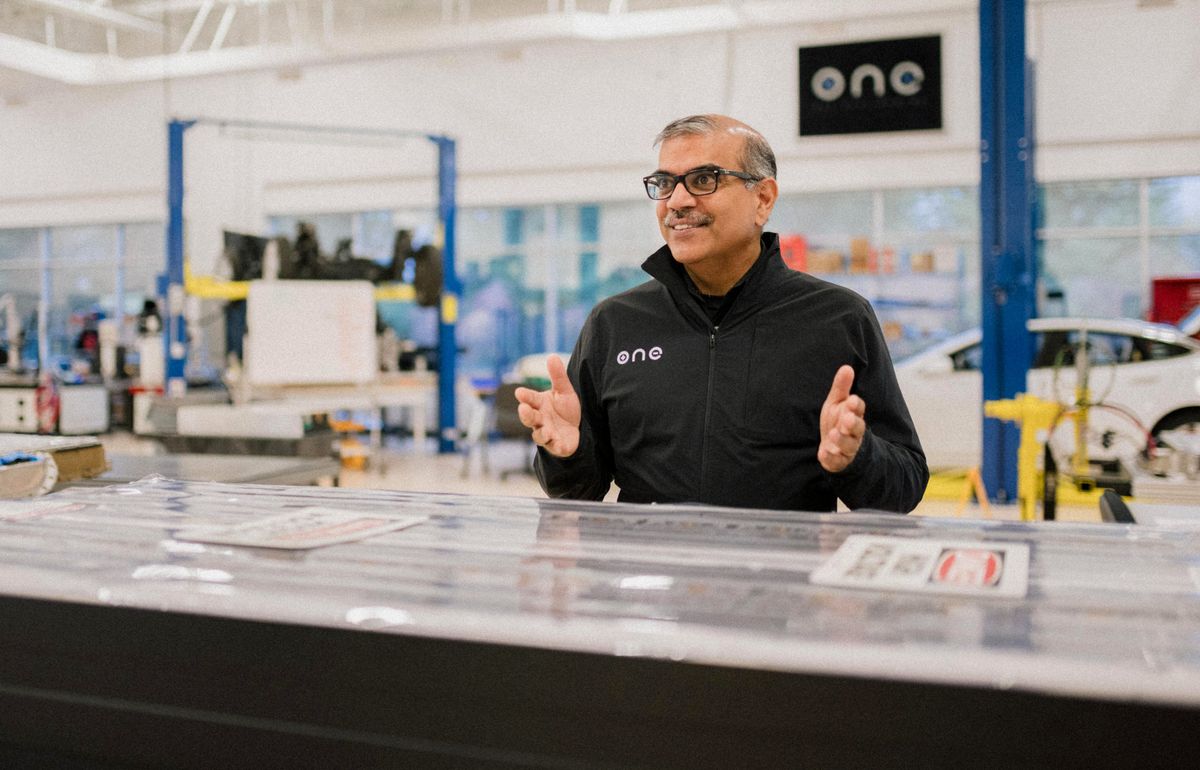Dragging a fledgling American battery company through myriad minefields into mass production is a daunting mission—even for a veteran battery engineer and executive who played lead roles with Apple’s hush-hush EV program, the now-defunct A123 Systems, and Ford.
In December, Mujeeb Ijaz stepped aside as CEO of Michigan-based Our Next Energy (ONE), following the layoffs of 128 employees and a funding round gone awry. Ijaz will remain as ONE’s chief technology officer and vice-chairman. And Ijaz says the company remains on track to open its One Circle gigafactory in Van Buren Township. The US $1.6 billion sustainable plant, including a $200 million grant from the state of Michigan, aims to bring 2,100 jobs, and produce its first Aries II LFP battery packs in 2025. The ultimate target sees the company supplying up to 200,000 EVs a year by 2027. That makes ONE another closely watched challenger to Chinese battery dominance via the Inflation Reduction Act, whose incentives have sparked more than $92 billion in homegrown investments in EV and battery manufacturing.
“We’re not the highest-performing LFP cell yet, but we are the highest pack-level energy density in the market.”
—Mujeeb Ijaz, Our Next Energy
That’s not all. Under an agreement with BMW Group, ONE outfitted a BMW iX electric SUV with its dual-chemistry Gemini battery, and demonstrated an impressive 979-kilometer (608-mile) driving range on Europe’s optimistic Worldwide harmonized Light vehicles Test Procedure (WLPT) cycle—or 830 km (516 miles) under the Environmental Protection Agency’s U.S. testing regime. IEEE Spectrum spoke with Ijaz about the company’s technology and prospects. Questions and answers were edited for space and clarity.
ONE says its new lithium-iron-phosphate (LFP) cells can close the performance gap between LFP and high-nickel chemistries such as nickel-manganese-cobalt (NCM). And the company kicked off cell production in November?
Mujeeb Ijaz: We have an LFP pilot line with 10 megawatt-hours that’s running in Van Buren Township, making our first automotive cell. And we’re qualifying that cell internally, before we release samples to OEMs [original equipment manufacturers] for testing by the end of the first quarter of 2024. We’re looking to scale that production from mega- to giga-scale in calendar year 2025.
What kind of energy density are you seeing from those LFP cells?
Ijaz: Our target density at a cell level is around 430 watt-hours per liter. We’ve measured against the best benchmarks in China, South Korea, and anything we can find in the U.S. market, and that places us in the 95th percentile or up. So we’re not the highest-performing LFP cell yet, but we are the highest pack-level energy density in the market. A key part of our strategy is to improve energy density at a system level.
EV and battery YouTuber Sandy Munro interviewed Mujeeb Ijaz last month at ONE’s new Michigan battery factory. ...
Cell-to-pack construction is kind of the secret sauce for that efficiency?
Ijaz: The best way to describe cell-to-pack is to think of the way an aircraft wing uses honeycomb as structure. If you look at the honeycomb itself, it’s very light, and the thin material itself is not very substantial. But it’s the structure being integrated that gives a very stiff total structure. What we’ve developed is a way to use the aluminum can that surrounds a lithium-ion cell as that lattice, or honeycomb. You then transfer loads through that to allow this heavy battery to be self-supporting without cross members or other structures, by leveraging the skin of the cell itself.
“The clear path was to invent a dual-chemistry battery...that fits the model of people who buy electric vehicles—not wanting electric cars because the range is too low.”
—Mujeeb Ijaz, Our Next Energy
In terms of driving range, your BMW iX beat BMW’s best production version by nearly 360 kilometers, a 58 percent improvement. This dual-chemistry Gemini pack prioritizes LFP operation to drive roughly the first 240 km (150 miles), then prioritizes the “anode-free” cells for longer trips, akin to a plug-in hybrid with a range-extending gasoline engine. Can you explain the approach?
Ijaz: The clear path was to invent a dual-chemistry battery where the traction LFP battery is for every day, with the range extender for long trips. That fits the model of people who buy electric vehicles—not wanting electric cars because the range is too low. The anode-free cell is technology that’s been underutilized because it did not have sufficient cycle life or power level to be a battery stand-alone. We analyzed how effective it would be to eliminate graphite to reduce cost and even manufacturing equipment to make the cell. But we also liked its energy density, because as you eliminate graphite, you make more room for cathode and nearly double the energy density.
And cycle life has been a technical challenge for these cells?
Ijaz: We just stared at that: How do we overcome the cycle life problem? For LFP batteries, more than 3,000 cycles have been observed, making it a solid 15-year product. The anode-free cells have about one-tenth that lifetime, but we don’t expect to use it for more than 1 percent of the vehicle’s lifetime daily distance driven. We’re trying to overdesign it so it never runs into a life problem. So in total life of product, we’ve allocated 100,000 miles of driving on the range extender, and 400,000 miles on the daily LFP battery, for a half-million miles of life designed in.
“We want to drive energy and range up, and cost per kilowatt hours down, and this is one of the few ways we’ve seen to achieve both at the same time.”
—Mujeeb Ijaz, Our Next Energy
Roughly how much more active battery material can you fit into a given space?
Ijaz: I’ll give you three numbers to compare. In a cylindrical pack, about 32 percent of the total volume is active cell. In a more-conventional automotive pack with modules, it’s around 44 to 49 percent. What we’re able to achieve is a little greater than 70 percent, of volume-of-cell versus volume-of-pack. So we’re at a very high percentage, which allows us to switch chemistries away from nickel and cobalt, and still achieve or exceed the same amount of range. The highest we’ve achieved at a pack level is 76 percent. The battery we put into the iX was 185 kilowatt-hours, and only about 100 kilograms heavier than the original (105-kWh) battery.

That dual-chemistry approach sounds complicated. How do convince an OEM to buy your Gemini battery, rather than take the easy path with a conventional battery from a familiar global supplier?
Ijaz: First, trucks and SUVs on American roads or Autobahn conditions in Europe are suffering a real-world range problem. Something like 40 percent of rated range can be lost when you drive at normal highway speeds, in a vehicle with not-great drag coefficient. Second, trucks like to tow, and towing with electric vehicles can drop your range to sub-120 miles (193 km) very quickly. So there’s a market-acceptance problem. That’s where OEMs are standing ready to listen to Gemini, as a way to dramatically boost range without increasing mass and size beyond the normal batteries in their vehicles.
As for the dual-chemistry being complicated, the operation, for when and how to move energy, is transparent. It looks like a battery running a single bus, and the drivetrain only knows that single battery. Internal software and electronics move energy between them, transparently, to the customer. If you’re depleting the battery quickly by towing, driving really fast, or in extreme conditions, you’ll move energy from the anode-free cells sooner. If you’re in a calm, commuter situation, it will avoid using the battery for the sake of life. We want to drive energy and range up, and cost per kilowatt hours down, and this is one of the few ways we’ve seen to achieve both at the same time.
Can you explain the chemistry in your anode-free cells?
Ijaz: The technical term would actually be “graphite free”; it still has an anode that’s a copper foil. But the idea is you don’t have to process this material in a factory: Lithium plates directly on the copper. That’s not a brand-new thing, but plating it and stripping it and getting decent life and safety in an automotive environment is what we’ve been working on.
Can you talk about the role the Inflation Reduction Act is playing in on-shoring battery development and manufacturing in the United States?
Ijaz: In terms of the cost of batteries, through importing Chinese-made cells, and our ability to scale and get traction in the near-term market, the IRA is essential to help us level the playing field. Over a seven- to 10-year period, our scale will allow us to take over and remain competitive. As we stand up an industry from scratch, we see a lot of OEMs recognize the value of diversifying supply chains. We’re benefiting from that, though EVs in the U.S. will require a significant period of investment. The IRA has made batteries for the grid somewhere around 57 percent cheaper than before, and that’s giving a lot of motivation to the market. The IRA is a recruiting tool to keep people steady as they go; then the market will take advantage of lower-cost energy-storage products, for grid, for solar, and for automotive. Those are the many markets we’re going after. It’s an emerging market, but a very tough market.
Lawrence Ulrich is an award-winning auto writer and former chief auto critic at The New York Times and The Detroit Free Press.



